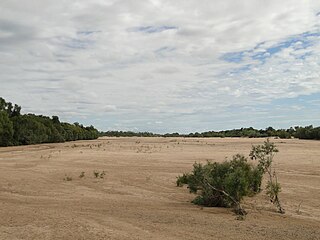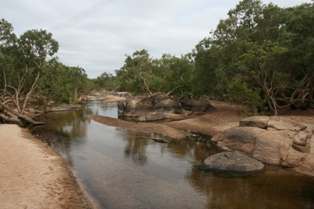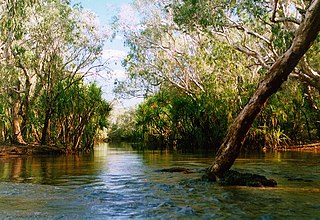
The Apudthama National Park is a national park in Queensland, Australia, 2,137 km (1,328 mi) northwest of Brisbane and about 900 km (559 mi) northwest of Cairns, on the tip of Cape York Peninsula.

The Fitzroy River is a river located in Central Queensland, Australia. Its catchment covers an area of 142,665 square kilometres (55,083 sq mi), making it the largest river catchment flowing to the eastern coast of Australia. It is also the largest river basin that discharges onto the Great Barrier Reef.

The Gilbert River is located in Far North Queensland, Australia. When combined with the Einasleigh River, the river system is the largest river system in northern Australia.

The Archer River is a river located on the Cape York Peninsula, Far North Queensland, Australia.
The Calvert River is a river in the Northern Territory of Australia.
The Blyth River is a river in the Northern Territory, Australia.
The Moyle River is a river in the Northern Territory, Australia.
The Goomadeer River is a river in the Northern Territory, Australia.

The Goyder River is a river in the Northern Territory of Australia.
The Robinson River is a river in Australia's Northern Territory.
The Nicholson River is a river located in the Northern Territory and the state of Queensland, Australia.

The Gregory River is a river located in the Northern Territory and the state of Queensland, Australia. The river is the largest perennial river in arid and semi-arid Queensland, one of the few permanently flowing rivers in the northwest of Queensland.
The Walsh River is a river located on the Cape York Peninsula of Far North Queensland, Australia.
The Coleman River is a river on the Cape York Peninsula in Far North Queensland, Australia.
The Black River is a river located in North Queensland, Australia.
The Haughton River is a river located in North Queensland, Australia.
The Holroyd River is a river located on the Cape York Peninsula in Far North Queensland, Australia.
The Jackey Jackey Creek, also often called Jacky Jacky Creek, is a creek located in the Cape York Peninsula region of Far North Queensland, Australia.
The Kendall River is a river located in Far North Queensland, Australia.
The Ankamuti were an indigenous Australian people of the Cape York Peninsula of Queensland.






